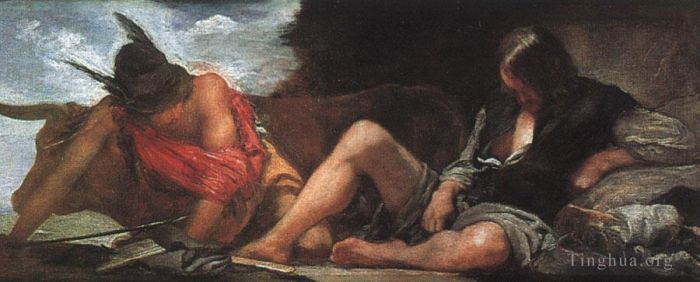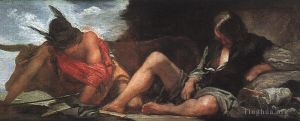Mercury and Argus
Diego Velazquez
- Price: Price on Request
- Art Type: Oil Painting
- Size:
- English Comments: 0
- International Comments: 0
- Creating Date:
- Introduction and Works of Diego Velazquez >>
Work Overview
- Mercury and Argus
Ca. 1659. Oil on unlined canvas, 127 x 250 cm
Wearing his characteristic winged hat, and with a pan flute next to his left hand, Mercury stealthily approaches a shepherd he has lulled to sleep with the unlimited powers of his music. The latter is the one-hundred-eyed Argos, whom Juno appointed to watch over Io, the beautiful nymph she had turned into a cow in order to protect her from the amorous advances of he husband, Jupiter. Fully aware of her strategy, the latter sent Mercury to bypass Argos and steal her.
This episode from Ovid´s Metamorphoses was the subject of one four mythological scenes that Velázquez painted for the decoration of the Hall of Mirrors and Madrid´s Alcázar Palace. From the standpoint of protocol and representativeness, that hall was the most important of the entire palace and its impressive panoply of paintings was part of its function. Most were either portraits of Spain´s Habsburg monarchs, or mythological or biblical scenes. The other three paintings from Velázquez´s series show Apollo flaying a satyr -a work of the same dimensions, as both were intended to hang between windows- and two somewhat smaller works depicting Venus and Adonis and Psyche and Cupid, respectively. They were all lost when the Alcázar burned in 1734. The series probably dates from the late 1650s, when the Hall of Mirrors was subjected to an intense process of decorative enrichment to make it the most sumptuous possible setting for receiving the Duke of Gramont, King Louis XIV´s ambassador, who arrived to negotiate the wedding between that monarch and Philip IV´s eldest daughter, María Teresa. This was also the context for other activities by Velázquez, including the project for decorating the ceiling with the story of Pandora, which was carried out by Colonna and Mitelli.
There has been considerable speculation about the meaning of this series, and the hall´s function has even prompted some political interpretations. The paintings were joined by their mythological nature, and the larger two share an allusion to music, while the smaller pair both allude to love. The erotic subject matter was appropriate for the ceremony that was to take place in 1659, and in fact, the story of Pandora has also received a matrimonial interpretation (Aterido and Pereda 2004). Stylistically, the only surviving canvas of the four is coherent with the artist´s works from the end of his career, when he carried his tendency to dissolve forms to its maximum consequences, blurring the limits between bodies and once again demonstrating his astonishing capacity to suggest life, movement and emotions with a few extraordinarily long and accurate brushstrokes. But Velázquez did not invent this painting ex-nihilo. As has frequently been pointed out, he based it on the Roman sculptural group that represents a dying Gaul. Like The Spinners, this work had pieces added to it: a strip approximately 25 cm. in width that runs along the entire top, and another narrower one (about 10 cm wide) at the bottom (Text from Portús, J.: Fábulas de Velázquez. Mitología e Historia Sagrada en el Siglo de Oro, Museo Nacional del Prado, 2007, pp. 336-337).
- Copyright Statement:
All the reproduction of any forms about this work unauthorized by Singing Palette including images, texts and so on will be deemed to be violating the Copyright Laws.
To cite this webpage, please link back here.
- >> English Comments
- >> Chinese Comments
- >> French Comments
- >> German Comments
- >>Report
- Philip IV
- View of the Gardens of the Villa Medici Rome
- Buffoon Barbarroja
- Pope Innocent X
- Don Luis de Gongora y Argote
- The Surrender of Breda
- Three Musicians aka Musical Trio
- Lady with a Fan
- Two Young Men at a Table
- Old Woman Frying Eggs
- Prince Felipe Prospero
- The Infanta Don Margarita de Austria
- The Toilet of Venus (Venus at her Mirror or The Rokeby Venus)
- Queen Isabel
- Mpther Jeronima de la Fuente
- De Acedo El Primo
- Pablo de Valladolid
- Philip IV in Brown and Silver
- Philip IV Standing
- Philip IV as a Hunter
- Juan de Pareja
- A Dwarf Holding a Tome in His Lap aka Don portrait Diego de Acedo el Primo
- Innocent X
- Young Man 1629
- The Poet Don Luis de Gngora y Argote
- Infante Don Carlos
- Sebastian de Morra
- Democritus
- Infante Philip Prosper dog
- Cardinale Ferdinand
- Portrait of a Man
- The Spinners (The Fable of Arachne)
- The Buffoon Calabazas2
- Philip IV 1624
- Philip IV Standing2
- Saint Paul
- Portrait of the Infanta Margarita
- Vulcan’s Forge
- Philip IV at Fraga
- Infante Philip Prosper
- Portrait of a Little Girl
- Head of a Deer
- Don portrait Diego del Corral y Arellano
- Portrait of a Man with a Goatee
- King Philip IV as a Huntsman
- Miguel Angelo Barber to the Pope
- Court Dwarf Don Antonio el Ingles
- Jester Don Juan de Austria
- The Buffoon Juan de Austria
- The Lunch (Luncheon or Breakfast)
- Young Peasant Girl
- The Temptation of St Thomas Aquinas
- St Ildefonso Receiving The Chasuble From The Virgin
- The Dwarf Francisco Lezcano
- Mercury and Argus
- Portrait of Innocent X
- A Sibyl
- Dona Antonia de Ipenarrieta y Galdos with Her Son
- Las Meninas
- The needlewoman
- Camillo Massimi
- Don Gaspar de Guzman Count of Olivares and Duke of San Lucar la Mayor
- Self
- A Dwarf Sitting on the Floor
- Queen Isabel Standing
- Prince Baltasar Carlos in Hunting Dress
- Supper at Emmaus
- John at Patmos
- Portrait of a Cleric
- Dona Antonia de Ipenarrieta y Galdos and her Son Luis
- Don Cristobal Suarez de
- Philip IV In Armour 1628
- Study For The Head Of Apollo
- Menippus
- Abbess Jeronima de la Fuente
- Francesco II dEste Duke of Modena
- Aesop
- A Young Lady
- Portrait of a Young Man 1626
- Francisco Bandres de Abarca
- Juan Martinez Montanes
- Queen Dona Mariana of Austria
- Josephs bloody coat
- Christ in the House of Mary and Marthe
- Philip IV on Horseback
- 4Velazquez Portrait of the Infanta Margarita
- The Buffoon Pablo de Valladolid
- View of Zaragoza
- Mars
- Maria Teresa of Spain with two watches
- Don Juan Mateos
- Dona Maria de Austria
- Don Gaspar de Guzman Count of Oliveres and Duke of San Lucar la Mayor2
- The Feast of Bacchus (The Triumph of Bacchus or Los borrachos)
- Portrait of Philip IV
- Sibyl
- Saint John at Patmos
- Don Baltasar Carlos with a Dwarf
- The Buffoon Don Cristobal de Castaneda y Pernia aka Red Beard
- The Buffoon Calabazas
- A Knight of the Order of Santiago
- Don Balthasar Carlos
- Saint Anthony Abbot and Saint Paul the Hermit
- THe Waterseller of Seville
- The Farmers Lunch (Peasants at the table)
- Infanta Marguarite Therese
- Prince Baltasar Carlos on Horseback
- Kitchen Scene With The Supper In Emmaus
- The crucified Christ
- The Adoration of the Magi
- Archne A Sybil
- The Sculptor Martinez Montanes
- The Coronation of the Virgin
- Velasquez2
- The Dwarf Don Juan Calabazas called Calabacillas
- Los Borrachos The Triumph of Bacchus
- Allegorical Portrait of Philip IV
- Cardinal Camillo Astalli
- The White Horse
- The Immaculate Conception
- Velasquez1
- Head Of A Girl
- Gaspar de Guzmán Count-Duke of Olivares on Horseback









 Singing Palette
Singing Palette